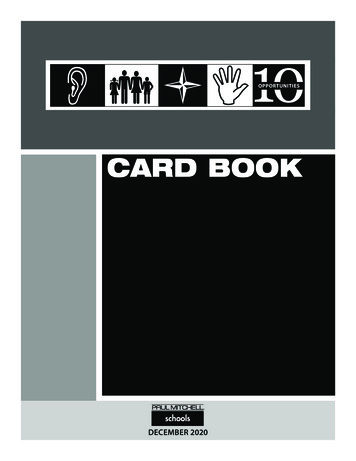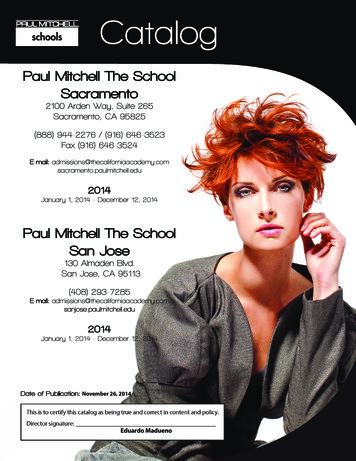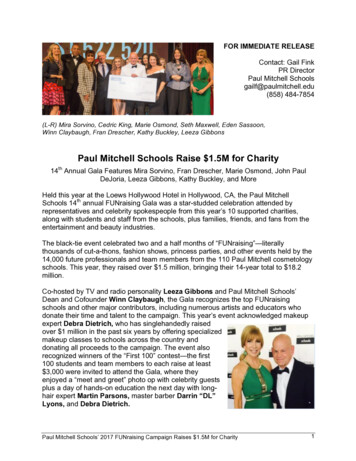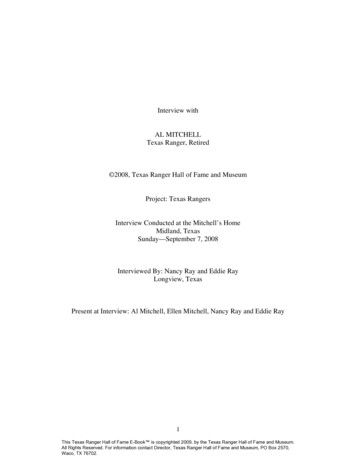
Transcription
O l I10OPPORTUNITIESCARD BOOKDECEMBER 2020
PTMSpublicationsFirst Published in the USA byPaul Mitchell Advanced Education, LLC9756 S. Sandy ParkwaySandy, Utah 84070(801) 302-8801www.paulmitchell.eduFirst Published 2004Copyright 2020 Paul Mitchell Advanced Education, LLCAll Rights Reserved. Printed in the United States of America.No part of this publication may be reproduced, stored in a retrieval system, or transmitted in any form or by any means electronic, mechanical, photocopying, recording, or otherwise, without prior permission of the publisher.Editor: Tina BensonDesign and Layout: Mary Beth LongmoreThis manual is the exclusive property of Paul Mitchell Advanced Education, LLC (“PMAE”), and is being loaned to PMAE licenseessolely for use in the operation of a Paul Mitchell Partner School or Paul Mitchell The School. This manual must be returned to PMAEpersonnel upon request or at the expiration or termination of the licensee’s right to operate as a Paul Mitchell School.The material in this manual shall not be copied or reproduced in whole or in part, except where indicated, without the writtenconsent of PMAE. This manual contains confidential business information that should not be shared with anyone who does nothave a legitimate “need to know” and who has not signed a confidentiality agreement. The manual must be kept at the PaulMitchell School premises and should be kept current by including updates, changes, and/or additions provided by PMAE.
Table of ContentsGuide qResource GuideNo cards included.Guide wThe VisionGuide eCommunication and CoachingGuide rGuide t1.2.3.4.5.6.1.2.3.4.5.6.7.8.9.10.11.12.Our MissionCustomer-Focused LeadershipForward FocusForward-Focused QuestionsTeam VisionValues vs. BehaviorsCreating MagicGolden RulesCommunication SuccessManaging ConflictGathering GuidelinesHuddleCoaching Success ProfileCoaching DialoguesF.A.C.E.Giving FeedbackRedirectingMediatingAdmissions: Attracting, Mentoring, and Servicing1. Paul Mitchell Tree of Opportunity2. Lead-to-Enrollment Terminology3. Paul Mitchell Schools Interview and Tour ExperienceService Desk and Clinic Classroom SystemsFuture Professional Skill Cards1. 4-Step Program2. 10 Opportunities3. Service Greeting4. Service Consultation5. Service Experience6. Style Consultation7. Service Completion8. 2-Minute PlanService Desk Team Skill Cards9. Telephone Skills10. Telephone Call11. Guest Welcome12. Guest Check-In13. Guest CheckoutSkill cards in BOLD indicate a new skill card or content update.
Guide yLearning Leader 8.19.20.21.22.23.24.25.26.27.28.29.30.31.Thinking Process — StringerThinking Process — GrouperMultiple IntelligenceVerbal/Linguistic IntelligenceMath/Logic IntelligenceSpatial IntelligenceBody/Kinesthetic IntelligenceMusical/Rhythmic IntelligenceInterpersonal IntelligenceIntrapersonal IntelligenceLearning CycleV.A.K.Learning TypesC.L.A.S.S. Skill #1 — VerbalC.L.A.S.S. Skill #2 — NonverbalC.L.A.S.S. Skill #3 — Asking and RespondingPower StatementsListening SkillsActivities — Active Learning ExperiencesActivities — Learning CentersActivities — Objective-Based EducationActivities — Mini-ClassesStructureLesson PlanningSummarizeGame Plan — Steps to BuildingGuiding PrinciplesCore Course OutlineProtégé Course OutlineAdaptive Course OutlineCreative Course OutlineGuide u –aStudent ProgramsGuide sLeadership and Operations1.2.3.4.5.6.7.8.9.Take Home and Brand TeamStudent CouncilPhase Two ProgramDesign TeamBe Nice (Or Else!) ClubGreen ClubQuitter’s ClubJohn Paul Pet ClubSocial Networking Club1. L.E.A.D.2. Staffing & Training Plan3. Keep It Real QuestionsSkill cards in BOLD indicate a new skill card or content update.
Card Book IntroductionWhy We Use the Card BookThe Card Book gives Learning Leaders and Future Professionals a handy visual tool, featuring PaulMitchell Schools’ learning and culture systems. We design the Card Book to provide Paul MitchellSchools with a collection of the tools available to enhance learning.What is the Card Book?The Card Book is a collection of the skill cards that appear in our guides. We use the skill cards in allLearning Leader training.How to Use the Skill CardsIt is important that Learning Leaders introduce and incorporate the skill cards in the classroom andduring peer and self-study at learning centers and in the clinic classroom. We suggest a variety ofuses for the cards:1. Use the skill cards as vocabulary flash cards as learners acquire the terminology of Core, Protégé,Adaptive, and Creative using the course outline skill cards. Play a memory game using the cardsas game pieces or props to rehearse new terms.2. Use the skill cards to establish your procedures and expectations with learners. For example,present the Huddle skill card to describe what the system accomplishes for the team and FutureProfessionals.3. Present the Values vs. Behaviors skill card and lead team members in making a personal chart oftheir values and behaviors to explore what the team values.4. During a lesson, have learners use the game planning skill card to follow the steps to createtheir own game plan. At the end of a lesson, lead learners in F.A.C.E.-ing each other with theF.A.C.E. skill card.5. Introduce the communication skill cards. Have learners practice C.L.A.S.S. communication skills byreading a story aloud to a partner and demonstrating as many skills as they can.6. Use the skill cards at a learning center to engage learners in the extended study of a topic. Givelearners a homeplay assignment to study a skill card prior to class as a preview for an upcominglesson.7. Ask, What if? Explore all of the possibilities of skill card games and activities!
How to Output the Skill CardsOwner’s Instructions The cards may be output directly from the PMS Card Book PDF located on The HUB.Printer’s Instructions Output the skill cards on 8.5x11-inch white cardstock. All cards are set up two cards per page with the front on one side and the back on the other. Copy the cards two-sided (page 1 on the front, page 2 on the back, and so on). After printing, cut the 8.5x11-inch cardstock pages in half to a final size of 5.5x8.5. A complete printing of the file will yield two sets of cards. Punch a ¼-inch hole in the upper left corner of the card.Note: The Card Book is formatted as a PDF file, a universally recognized format, which can be opened onboth PC and Mac computers. Adobe Acrobat Reader is required to open the PDF files.Note: Do not alter or change any information contained on the Paul Mitchell Schools skill cards.How to Assemble the Skill Cards Keep the cards in sequence and place them in numerical order following the card numbers. The cardnumbers are located on the back of each card. The card number refers to the card order (ex. 5.2 Guide 5, Card 2). Use a silver, one-inch clasping ring to assemble the cards. Rings are available at most office supplystores.
O l I10OPPORTUNITIESCARDSGuide wTHE VISION1.2.3.4.5.6.Our MissionCustomer-Focused LeadershipForward FocusForward-Focused QuestionsTeam VisionValues vs. Behaviors
When peoplecome first,success willfollow.How we support our visionWhen peoplecome first,success willfollow.How we support our visionOur MissionOur Mission
Step 5Step 4Step 3Step 22. 1Implement the mission.Gain consensus and agreementfrom all team members.Craft a statement that embodiesthe team’s vision.Create and agree upon a teamvision.Identify the team’s valuesand beliefs.Step 5Step 4Step 3Step 2Step 12. 1Implement the mission.Gain consensus and agreementfrom all team members.Craft a statement that embodiesthe team’s vision.Create and agree upon a teamvision.Identify the team’s valuesand beliefs.Build Your MissionBuild Your MissionStep 1Our MissionOur Mission
Traditional VisionTraditional VisionTeachersManagersHappyBossHappy Leadersand ManagersHappy Learning LeadersStudentsHappyBossHappy Leadersand ManagersHappy Learning LeadersBossHappy Future ProfessionalsHappy Future ProfessionalsStudentsTeachersManagersBossNew VisionHow we lead ourselvesHow we lead ourselvesNew VisionCustomer-Focused LeadershipCustomer-Focused Leadership
In this model of leadership, the Future Professional isthe most important customer.We make all decisions with the customer in mind. Wefunnel the customer’s input down to the leadershipthrough all team levels.This process keeps the flow of communication open andempowers all team members to make decisions thatcontribute to the overall customer experience.We focus on three customers:1. Future Professionals, our students2. Service guests3. Team members and leadersThe owner works to serve and direct by modelingthe customer-focused leadership approach.In this model of leadership, the Future Professional isthe most important customer.We make all decisions with the customer in mind. Wefunnel the customer’s input down to the leadershipthrough all team levels.This process keeps the flow of communication open andempowers all team members to make decisions thatcontribute to the overall customer experience.We focus on three customers:1. Future Professionals, our students2. Service guests3. Team members and leadersThe owner works to serve and direct by modelingthe customer-focused leadership approach.2. 2Begins with a change in how we useinput and make decisionsBegins with a change in how we useinput and make decisions2. hip
Front SideBacksideBackside–Front Side A process for managing your thoughts and energyA process for managing your thoughts and energy–Forward FocusForward Focus
What steps can I taketo make this work?This won’t work!What if I gave it a try?2. 3*Adapted from Steven Vannoy’s The 10 Greatest Gifts I Give My Children2. 3*Adapted from Steven Vannoy’s The 10 Greatest Gifts I Give My ChildrenRecognize where you are.Make a 10% shift.Practice the three laws of the mind.Ask forward-focused questions.What I love is What will bring me joy?1.2.3.4.Recognize where you are.Make a 10% shift.Practice the three laws of the mind.Ask forward-focused questions.I’ll get it done!What I like is.I am responsible for 1.2.3.4.I’m too scared to try it.I hate that.Will this be painful?It’s your fault!I tried to make it happen.This is what I don’t like!How will I improve thissituation?What steps can I taketo make this work?I have a solution! Front Side ThinkingSteps to Become Forward FocusedWhat if I gave it a try?What I love is What will bring me joy?I am responsible for I’ll get it done!What I like is.What’s wrong withthis situation?This won’t work!This is a problem.Backside Thinking–Forward-Focused ThinkingSteps to Become Forward FocusedI’m too scared to try it.I hate that.Will this be painful?It’s your fault!I tried to make it happen.This is what I don’t like!How will I improve thissituation?I have a solution!This is a problem.What’s wrong withthis situation?Front Side Thinking Backside Thinking–Forward-Focused Thinking
Forward-FocusedQuestionsQuestions that focus on solutionsForward-FocusedQuestionsQuestions that focus on solutions
2. Link it with positive or neutral words. to fine-tune our coaching skills?3. Create a solution or resolve a challenge. What can we do to fine-tune our coachingskills?2. 4 to fine-tune our coaching skills?3. Create a solution or resolve a challenge. What can we do to fine-tune our coachingskills?2. 4What can we do 2. Link it with positive or neutral words.What can we do 1. Ask an open-ended question.Forward-Focused FormulaForward-Focused Formula1. Ask an open-ended estions
20%50%30%The role you choose to play20%50%30%The role you choose to playTeam VisionTeam Vision
30%50%20%2. 530% 2. 5Resisters think it is their job to resist, resist, resist.T hese are team members who resist, criticize,and undermine the vision.T hese are team members who resist, criticize,and undermine the vision.Resisters think it is their job to resist, resist, resist.ResistersResisters Their support changes and is inconsistent. Fence sitters go either way on anything. Sometimesthey are for and other times they are against theteam. Their support changes and is inconsistent.50%These are team members who are not fully committed tothe vision.These are team members who are not fully committed tothe vision. Fence sitters go either way on anything. Sometimesthey are for and other times they are against theteam.Fence SittersFence Sitters Visionaries show up each day with the attitude of“What’s in it for us?” They support the team, the systems, and the teamgoals 100 percent!20% They support the team, the systems, and the teamgoals 100 percent! Visionaries show up each day with the attitude of“What’s in it for us?”These are the leaders within the organization who seeand support the vision.These are the leaders within the organization who seeand support the vision.All people can be divided into three differentcategories of behavior. Each team member chooseson an ongoing basis the role he or she will play:All people can be divided into three differentcategories of behavior. Each team member chooseson an ongoing basis the role he or she will play:VisionariesRole You ChooseRole You ChooseVisionariesTeam VisionTeam Vision
Your behaviors must support your values.vs. Behaviorsvs. BehaviorsYour behaviors must support your values.ValuesA values evaluation processA values evaluation processValuesValues vs. BehaviorsValues vs. Behaviors
Support the whole person.We recognize and support the balancing andhealth of our team members and focus onbalancing our own lifestyles.Build successful relationships.We focus on building relationships, playing, andworking as a team as we perform our tasks.Support team guidelines.Our team recognizes that to build trust we mustfollow our professional guidelines and commit toour zero-tolerance policy and professional code ofconduct.Follow the 24-Hour Rule.We promptly respond to all requests and resolveconflict promptly.Own it.When we recognize that something needs to bedone, we do it!Use forward focus.We stay positive and focus on finding solutionsand opportunities.Create Magic!We Create Magic! first and commit to beingpresent with our Future Professionals, teammembers, and service guests.Balanced team membersSuccessful relationshipsHonesty and integrityResponsive communicationPersonal responsibilityand accountabilityPositive energy and energymanagementFun and positive environment2. 6Show customer-focused leadership.We consider our Future Professionals, ourcustomers, in every decision we make.Happy Future ProfessionalsHow We BehaveFun and positive environmentPositive energy and energymanagementPersonal responsibilityand accountabilityResponsive communicationHonesty and integritySuccessful relationshipsBalanced team membersHappy Future ProfessionalsWhat We Value2. 6Create Magic!We Create Magic! first and commit to beingpresent with our Future Professionals, teammembers, and service guests.Use forward focus.We stay positive and focus on finding solutionsand opportunities.Own it.When we recognize that something needs to bedone, we do it!Follow the 24-Hour Rule.We promptly respond to all requests and resolveconflict promptly.Support team guidelines.Our team recognizes that to build trust we mustfollow our professional guidelines and commit toour zero-tolerance policy and professional code ofconduct.Build successful relationships.We focus on building relationships, playing, andworking as a team as we perform our tasks.Support the whole person.We recognize and support the balancing andhealth of our team members and focus onbalancing our own lifestyles.Show customer-focused leadership.We consider our Future Professionals, ourcustomers, in every decision we make.How We BehaveIn order to maintain a strong culture of teamwork and self-esteem, yourbehaviors must match your values. Here are some examples of what wevalue and how we behave to support our values.In order to maintain a strong culture of teamwork and self-esteem, yourbehaviors must match your values. Here are some examples of what wevalue and how we behave to support our values.What We ValueValues vs. BehaviorsValues vs. Behaviors
O l I10OPPORTUNITIESCARDSGuide eCOMMUNICATION AND COACHING1.Creating Magic2.Golden Rules3.Communication Success4.Managing Conflict5.Gathering Guidelines6.Huddle7.Coaching Success Profile8.Coaching Dialogues9.F.A.C.E.10. Giving Feedback11. Redirecting12. Mediating
How to be in the present and be with peopleCreate Magic First!Create Magic First!Creating MagicHow to be in the present and be with peopleCreating Magic
STEP 2MAKE PEOPLE FEEL IMPORTANT When first arriving at the school, remember to CreateMagic! first. Make it a priority to connect with people andpositively influence them before you focus on your tasksfor the day or walk to your office.STEP 3 BE PRESENT AND “PLAY” Create Magic! by participating. Schedule time to “be”with others, not just “do” with others. Be present and playin meetings, stop in classrooms, and wander around theclinic classroom to Create Magic!STEP 4MAKE THE ORDINARY EXTRAORDINARY Create your special magic. Find ways to motivate, help,and guide your team and Future Professionals withyour own magic. Transform an everyday ritual into anextraordinary, magical experience.STEP 5COMMUNICATE AND CELEBRATE VICTORIES Create Magic! through communication. Share yourstory and be a cheerleader. Celebrate the big and smallvictories every day.STEP 2MAKE PEOPLE FEEL IMPORTANT When first arriving at the school, remember to CreateMagic! first. Make it a priority to connect with people andpositively influence them before you focus on your tasksfor the day or walk to your office.STEP 3 BE PRESENT AND “PLAY” Create Magic! by participating. Schedule time to “be”with others, not just “do” with others. Be present and playin meetings, stop in classrooms, and wander around theclinic classroom to Create Magic!STEP 4MAKE THE ORDINARY EXTRAORDINARY Create your special magic. Find ways to motivate, help,and guide your team and Future Professionals withyour own magic. Transform an everyday ritual into anextraordinary, magical experience.STEP 5COMMUNICATE AND CELEBRATE VICTORIES Create Magic! through communication. Share yourstory and be a cheerleader. Celebrate the big and smallvictories every day.3. 1STEP 1ALWAYS BE IN A GREAT MOOD Remember our Golden Rule — always be in a great moodand fake it when necessary. Before you walk into thedoor, take a deep breath, smile, and think “It’s showtime!”Choose your focus.STEP 1ALWAYS BE IN A GREAT MOOD Remember our Golden Rule — always be in a great moodand fake it when necessary. Before you walk into thedoor, take a deep breath, smile, and think “It’s showtime!”Choose your focus.3. 1Creating MagicCreating Magic
GRGRGOLDEN RULESA code of conductA code of conductGOLDEN RULESGolden RulesGolden Rules
Gossip is not allowed.Hold each other accountable by the 24-Hour Rule.Resolve all personal challenges with love.5.6.7.7.6.5.4.Resolve all personal challenges with love.Hold each other accountable by the 24-Hour Rule.Gossip is not allowed.Be informed. Read all memos and information.Come to work prepared.10. Always “look the part” of an impeccable professional(classic, dramatic, or fashion forward).12. Do not get personally involved with FutureProfessionals or guests.13. Personal lives remain personal.3. 211. Always be professional.12. Do not get personally involved with FutureProfessionals or guests.13. Personal lives remain personal.3. 211. Always be professional.Be knowledgeable, literate, and articulate.10. Always “look the part” of an impeccable professional(classic, dramatic, or fashion forward).Be knowledgeable, literate, and articulate.9.Be informed. Read all memos and information.4.3.Always be in a great mood. Fake it when necessary.9.Come to work prepared.3.2.Be on time or early. Always!8. Go to the decision-maker with any apparent unsolvablechallenges. Use the “Go In Asking” Rule.Always be in a great mood. Fake it when necessary.2.1.Golden Rules8. Go to the decision-maker with any apparent unsolvablechallenges. Use the “Go In Asking” Rule.Be on time or early. Always!1.Golden Rules
Communication that builds relationshipsCommunication SuccessCommunication that builds relationshipsCommunication Success
TIP 8 Listen! Listen with thoughtful attention. Pay attention to the intent andcontent of the message.TIP 9 Communicate through conflict.Go in asking — Come from a place of wonder.TIP 8 Listen! Listen with thoughtful attention. Pay attention to the intent andcontent of the message.TIP 9 Communicate through conflict.Go in asking — Come from a place of wonder.3. 33. 3TIP 11 Create Magic! Be aware of the power your presence has on others.Be with people by being in the present moment.TIP 7 Choose words that are neutral or positive. Choose words and phrases toenhance the quality of your message.TIP 7 Choose words that are neutral or positive. Choose words and phrases toenhance the quality of your message.TIP 11 Create Magic! Be aware of the power your presence has on others.Be with people by being in the present moment.TIP 6 Stay direct and focused. Communicate directly with others rather thanworking around someone with whom you are having a conflict.TIP 6 Stay direct and focused. Communicate directly with others rather thanworking around someone with whom you are having a conflict.TIP 10 Participate in meetings. Connect daily, weekly, and monthly throughpositive and productive team gatherings. Schedule and facilitate: Huddle Management Meetings Town Hall Team Training and Certification ReinventionTIP 5 Ask forward-focused questions. Help others to find solutions by askingforward-focused questions. Use the forward-focused question formula. Askan open question that is linked with a positive phrase.TIP 5 Ask forward-focused questions. Help others to find solutions by askingforward-focused questions. Use the forward-focused question formula. Askan open question that is linked with a positive phrase.TIP 10 Participate in meetings. Connect daily, weekly, and monthly throughpositive and productive team gatherings. Schedule and facilitate: Huddle Management Meetings Town Hall Team Training and Certification ReinventionTIP 4 Share your knowledge. Be knowledgeable and humbly share what youknow with others.TIP 4 Share your knowledge. Be knowledgeable and humbly share what youknow with others.Use the sandwich technique — Support others as you provide feedback.TIP 3 Be clear. Be consistent. Communication is strongest when your wordssupport your actions. Our actions speak the loudest.TIP 3 Be clear. Be consistent. Communication is strongest when your wordssupport your actions. Our actions speak the loudest.Use the sandwich technique — Support others as you provide feedback.TIP 2 Manage your intentions. Communicate with the intent to make thingsbetter. Manage your energy and clarify your intentions.TIP 2 Manage your intentions. Communicate with the intent to make thingsbetter. Manage your energy and clarify your intentions.Use the 24-Hour Rule — Resolve challenges as they happen.TIP 1 Be open and available. Show that you are open and available tocommunicate through positive body language.TIP 1 Be open and available. Show that you are open and available tocommunicate through positive body language.Use the 24-Hour Rule — Resolve challenges as they happen.Communication SuccessCommunication Success
Go in asking.Follow the24-Hour Rule.Use the“sandwich technique.”Follow the24-Hour Rule.Use the“sandwich technique.”Successfully communicate through conflictGo in asking.Successfully communicate through conflictManaging ConflictManaging Conflict
STEP 2 Ask forward-focused questions.STEP 3 Make sure the tone of your voice and bodylanguage reflect your intention to understandrather than accuse.TO FOLLOW THE 24-HOUR RULE:Respond and follow up with a request for information,assistance, or resolution within a 24-hour period via e-mail ortelephone or in person.TO USE THE “SANDWICH TECHNIQUE”:STEP 1 Begin with a positive statement that reflects yourintention and sets the tone.STEP 2 Give direct, yet neutral, feedback using “I,” ratherthan “you,” messages.STEP 3 End with a positive statement to show yourintention to make things better.STEP 2 Ask forward-focused questions.STEP 3 Make sure the tone of your voice and bodylanguage reflect your intention to understandrather than accuse.TO FOLLOW THE 24-HOUR RULE:Respond and follow up with a request for information,assistance, or resolution within a 24-hour period via e-mail ortelephone or in person.TO USE THE “SANDWICH TECHNIQUE”:STEP 1 Begin with a positive statement that reflects yourintention and sets the tone.STEP 2 Give direct, yet neutral, feedback using “I,” ratherthan “you,” messages.STEP 3 End with a positive statement to show yourintention to make things better.3. 4STEP 1 Speak to the person in private and one-to-one.STEP 1 Speak to the person in private and one-to-one.3. 4TO GO IN ASKING:Managing ConflictTO GO IN ASKING:Managing Conflict
Guidelines for creating effective staff meetingsGuidelines for creating effective staff meetings Gathering GuidelinesGathering Guidelines
4. There are no dumb questions or dumb answers.5. Criticizing, teasing, put-downs, and sarcasm arethe only taboos.6. It’s okay to say, “I don’t know” or “I changed my mind.”7. If you don’t agree, say so and explain your thoughts.8. It’s good to have a mind of your own.Use it when it matters.9. Keep asking until you really understand.10. Failure is not fatal!4. There are no dumb questions or dumb answers.5. Criticizing, teasing, put-downs, and sarcasm arethe only taboos.6. It’s okay to say, “I don’t know” or “I changed my mind.”7. If you don’t agree, say so and explain your thoughts.8. It’s good to have a mind of your own.Use it when it matters.9. Keep asking until you really understand.10. Failure is not fatal!3. 53. There is no such thing as a “complaint,”only suggestions with (at least two) solutions.3. There is no such thing as a “complaint,”only suggestions with (at least two) solutions.3. 52. There are no “problems,” only challenges and opportunities.Guidelines 2. There are no “problems,” only challenges and opportunities.Gathering1. Sit in a circle.Guidelines 1. Sit in a circle.Gathering
HuddleDaily communication and planning systemHuddleDaily communication and planning system
Inspect team checklist: On time Nametag Dress code Attitude3. 66. Do an energizer!5.4. Review the calendar and daily events.Create daily focuses: Customer Service Fun Focus TeamworkCreate daily focuses: Customer Service Fun Focus TeamworkInspect team checklist: On time Nametag Dress code Attitude3. 66. Do an energizer!5.4. Review the calendar and daily events.3.2. Set daily goals.2. Set daily goals.3.1. Celebrate victories.1. Celebrate victories.
Knowledge Attitude BehaviorDevelopment outline to become a successful coachKnowledge Attitude BehaviorDevelopment outline to become a successful coachCoaching Success ProfileCoaching Success Profile
Be open, receptive, andapproachable.C.L.A.S.S. Communication Skills Verbal Nonverbal Asking questions Listening3. 73. 7Consistently follow up.Practice skilled verbal andnonverbal communication.Listen with thoughtfulattention.Consistently follow up.Be solution-oriented.Be inquisitive.Be intent tounderstand.Be a cheerleader.Tune in to your team andcustomize your coachingmessage.Schedule and prepare to coach.Praise and give feedback.Communicate throughconflict.A.B.C. — Always becoaching.Brainstorm creativesolutions and alternatives.Mediating ConflictRedirectingGiving FeedbackF.A.C.E. — PraisingTuning in to Learning TypesBe clear, concise, andconsistent.Be forward focused.Be open, receptive, andapproachable.Be present.Manage your intent.Brainstorm creativesolutions and alternatives.Practice skilled verbal andnonverbal communication.Listen with thoughtfulattention.Tune in to your team andcustomize your coachingmessage.Schedule and prepare to coach.C.L.A.S.S. Communication Skills Verbal Nonverbal Asking questions ListeningForward-Focused ThinkingMastering Coaching ContentEffective coaching requires knowledge of our culture systems,the attitude of wanting to make things better, and the commitmentto first modeling, then directing, consistent, successful behavior.Be solution-oriented.Be inquisitive.Be intent tounderstand.Be a cheerleader.Be clear, concise, andconsistent.Praise and give feedback.Communicate throughconflict.A.B.C. — Always becoaching.Effective coaching requires knowledge of our culture systems,the attitude of wanting to make things better, and the commitmentto first modeling, then directing, consistent, successful behavior.Mediating ConflictRedirectingGiving FeedbackF.A.C.E. — PraisingTuning in to Learning TypesBe present.Forward-Focused ThinkingBe forward focused.Manage your intent.Knowledge Attitude BehaviorKnowledge Attitude BehaviorMastering Coaching ContentCoaching Success ProfileCoaching Success Profile
How to give feedback, redirect, and mediateCoaching DialoguesHow to give feedback, redirect, and mediateCoaching Dialogues
Giving FeedbackThe process of directing learning and jobperformance.RedirectingThe process of coaching serious or patterned performance issues and conflicts.Mediating ConflictThe process of helping others to workthrough their personal and professionalchallenges with one another.Giving FeedbackThe process of directing learning and jobperformance.RedirectingThe process of coaching serious or patterned performance issues and conflicts.Mediating ConflictThe process of helping others to workthrough their personal and professionalchallenges with one another.3. 8The process of F.A.C.E.-ing to celebratevictories in learning and meet
1. Paul Mitchell Tree of Opportunity 2. Lead-to-Enrollment Terminology 3. Paul Mitchell Schools Interview and Tour Experience Guide t Service Desk and Clinic Classroom Systems Future Professional Skill Cards 1. 4-Step Program 2. 10 Opportunities 3.Service Greeting 4. Service Consultation 5. Service Experience 6. Style Consultation 7. Service .










